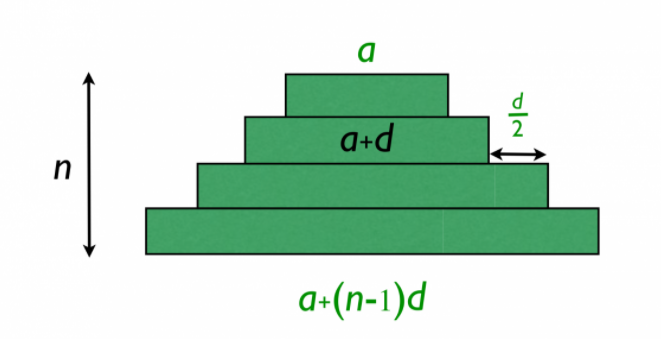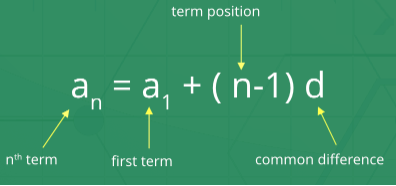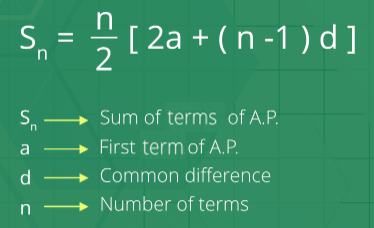ARITHMETIC PROGRESSIONS for Class 10 MATHS
Arithmetic Progressions
Arithmetic progression ek special case hai sequence ka, jismei do terms ke beech ka difference denote kiya jata hai d se aur throughout the series ye difference same rehta hai.
General form of an A.P. is
→ a, a + d, a + 2d, a + 3d,...............…........ 
Yha common difference kya hai A.P. ka
→ d = (a+2d)−(a+d)
→ Common Difference = d
where, a is first term and the nth term (or the general term) is
an=a+(n–1)d.

…where a = first term, d = common difference, n = term number.
Note: → Common difference should be same throughout AP.
For example
(i) 10,20,30,40,50,...
(ii) 20,18,16,14,12,...
(iii) 2,2,2,2,2,...
(iv) −5,−2.5,0,2.5,5,7.5,...
Given series ke pattern ko agar hum observe kare to (i)st part ke har ek term mein agar hum 10 add kare to hume series ka next term mil jayega. Issi tarah se (ii)nd part ke har ek term mein agar hum 2 add karte hai to hume next term mil raha hai aur aise hi (iii) part mei hum 0 add ya subtract karte hai to hume series ka next term mil raha hai, (iv) mei agar hum har ek term mei 2.5 add kare to hume series ka next term mil jayega.
Ab ise hum do tarah se samjh sakte hai ya to aise ki series kis tarh se badh rahi hai ya phir do consecutive numbers ke beech ka difference check kar ke.
Example 1
Show that the progression 11, 6, 1, -4, -9, …. is an AP. Find its first term and the common difference.
Clearly, (6−11)=(1−6)=(−4−1)=(−9+4)=−5 (constant).
Thus, each term differs from its preceding term by −5.
So, the given progression is an AP.
Its first term =11 and common difference =−5.
nth Term of an AP
Let a1,a2,a3,... be an AP whose first term a1 is a and the common difference is d. Then,
the second term, a2=a+d=a+(2–1)d
the third term, a3=a2+d=(a+d)+d=a+2d=a+(3–1)d
the fourth term, a4=a3+d=(a+2d)+d=a+3d=a+(4–1)d
nth term, an=a+(n–1)d.
The nth term, an of the AP with first term a and common difference d is given by an=a+(n–1)d.
an is also called the general term of the AP. The last term of AP is sometimes also denoted by l.
Note:
1. From a,d,n,an we need to know three of them to find fourth one using formula an=a+(n–1)d.
2. If an is given then we will replace n with n+1 to get an+1, then find an+1−an, if it is independent of n then an will form AP.
3. If there are n terms in AP then mth term from backward is (n−m+1)th term from starting i.e. an−m+1. Used when first term is known.
Or we can find it with an−(m−1)d or l−(m−1)d where an or l is last term.
Used when last term is known.
Sometimes we require certain number of terms in AP. Then we select term of as follows:
No. ofTermsC.D.terms____________________3a−d,a,a+dd4a−3d,a−d,2da+d,a+3d5a−2d,a−d,a,da+d,a+2d6a−5d,a−3d,2da−d,a+d,a+3d,a+5d
C.D.=common difference
In case of an odd number of terms, the middle term is a and the common difference is d while in case of an even number of terms the middle terms are a−d,a+d and the common differences is 2d.
Example 2
Find the (i) nth term and (ii) 16th term of the AP 3, 5, 7, 9, 11, …......
The given AP is 3, 5, 7, 9, 11, …
Its first term =3 and common difference =(5−3)=2.
∴ a=3 and d=(5−3)=2.
(i) Its nth term is given by
Tn=a+(n−1)d
=3+(n−1)×2=(2n+1) [because a=3 and d=2].
∴nthterm=(2n+1)
(ii) 16th term of the given AP is
T16=a+(16−1)d=(a+15d)
=(3+15×2)=33 [because a=3 and d=2]
∴ 16th term =33.
Sum of First n Terms of an AP
To find the sum of the first n terms of an AP :
a,a+d,a+2d,...,a+(n−1)d
The nth term of this AP is a+(n−1)d. Let S denote the sum of the first n terms of the AP. We have
S=a+(a+d)+(a+2d)+...+[a+(n−1)d] ...(1)
Rewriting the terms in reverse order, we have
S=[a+(n−1)d]+[a+(n−2)d]+...+(a+d)+a ...(2)
On adding (1) and (2), term-wise. We get
2S=([2a+(n−1)d]+[2a+(n−1)d]+.........+[2a+(n−1)d])
2S=n[2a+(n−1)d] (since, there are n terms)
S=n2[2a+(n−1)d]
The sum of the first n terms of an AP is given by
S=n2[2a+(n−1)d]
We can also write
S=n2[a+a+(n−1)d]
i.e. S=n2[a+an]
If there are only n terms in an AP, then an=l, the last term.
We get,
S=n2[a+l]
Let Sn=1+2+3+..............+n
Here a=1 and the last term l is n
Therefore, Sn=n(1+n)2 or Sn=n(n+1)2
So, the sum of first n positive integers is given by
Sn=n(n+1)2
Note:
1. nth term of AP can be also given by an=Sn−Sn−1, where Sn−1 can be obtained by replacing n by n−1
2. If nth term is given then from that find first term a and common difference d to calculate sum of AP i.e. if an=2n+1, then a1 is first term and a2−a1 is common difference.

Example 3
Sum of first 20 positive integers will be :
We have to find the sum of first 20 positive integers that means
S20=1+2+3+...+20
As we know that sum of first n positive integers is n(n+1)2. So,
S20=(20)(20+1)2=210
Example 4
Find the sum of first 24 terms of the AP 5, 8, 11, 14,…
Here a=5, d=(8−5)=3 and n=24.
Using the formula, Sn=n2.{2a+(n−1)d}, we get
S24=242⋅{2×5+(24−1)×3} [because a=5, d=3 and n=24]
=12×(10+69)=948.
Hence, the sum of first 24 terms of the given AP is 948.
Example 5
Ramkali required Rs 2500 after 12 weeks to send her daughter to school. She saved Rs100 in first week and increased her weekly savings by Rs 20 every week. Find whether she will be able to send her daughter to school after 12 weeks.?
The amounts saved by Ramkali in successive weeks are Rs. 100, Rs. 120 Rs. 140, Rs. 160,…. up to 12 terms.
These amounts form an AP in which a=100,d=20 and n=12.
Using Sn=n2×[2a+(n−1)d], we get
S12=122×[2×100+11×20]=(6×420)=2520>2500.
Thus, Ramkali will be able to deposit her daughter's fees and so she can send her to school.
Example 6
The houses of a row are numbered consecutively from 1 to 49. Show that there is a value of x such that the sum of the numbers of the houses preceding the house numbered x is equal to the sum of the numbers of the houses following it. Find this value of x (Hint: Sx−1=S49−Sx)
We are given an AP, namely
1,2,3,...,(x−1),x,(x+1),…,49
Such that 1+2+3+…+(x−1)=(x+1)+(x+2)+…+49.
Thus, we have Sx−1=S49−Sx…(i)
Using the formula, Sn=n2(a+l) in (i), we have
(x−1)2⋅{1+(x−1)}=492⋅(1+49)−x2⋅(1+x)
⇒x(x−1)2+x(x+1)2=1225
⇒2x2=2450⇒x2=1225⇒x=√1225=35
Hence, x=35.
Example 7
200 logs are stacked in such a way that there are 20 logs in the bottom row, 19 in the next row, 18 in the next row and so on. In how many rows, 200 logs are placed and how many logs are there in the top row ?
Let the required number of rows be n. Then,
20+19+18+…to n terms =200.
This is an arithmetic series in which
a=20,d=(19−20)=−1 and Sn=200.
We know that Sn=n2⋅{2a+(n−1)d}
∴n2⋅{2×20+(n−1)×(−1)}=200
⇒n(41−n)=400⇒n2−41n+400=0
⇒n2−25n−16n+400=0⇒n(n−25)−16(n−25)=0
⇒(n−25)(n−16)=0⇒n−25=0orn−16=0
⇒n=25 or n=16.
Now, T25=(a+24d)=20+24×(−1)=−4.
This is meaningless as the number of logs cannot be negative.
So, we reject the value n = 25.
∴n=16. Thus, there are 16 rows in the whole stack.
Now, T16=(a+15d)=20+15×(−1)=20−15=5.
Hence, there are 5 logs in the top row.
Summary
1. An arithmetic progression (AP) is a list of numbers in which each term is obtained by adding a fixed umber d to the preceding term, except the first term. The fixed number d is called the common difference.
The general form of an AP is a,a+d,a+2d,a+3d,...
2. A given list of numbers a1,a2,a3,... is an AP, if the differences a2−a1,a3−a2,a4−a3,..., give the same value, i.e., if ak+1−ak is the same for different values of k.
3. In an AP with first term a and common difference d, the nth term (or the general term) is given by an=a+(n−1)d.
4. The sum of the first n terms of an AP is given by :
S=n2[2a+(n−1)d]
5. If l is the last term of the finite AP, and AP has only n terms, then the sum of all terms of the AP is given by :
S=n2(a+l)

Let's Revise
Aisa progression jisme consecutive terms ka difference constant ho ussey arithmetic progression(A.P) kahtey hai. Example: 3,5,7,9,11…. is an arithmetic progression.
(i) Finite A.P wo A.P hota hai jisme number of terms finite ho yani hume last term ka pta ho ya hum calculate kar sakey. For example: A.P: 1,3,5,7,...,21.
(ii) Infinite A.P wo A.P hota hai jisme number of terms infinite ho yani ki humey na hi last term pta hai aur na hi hum ussey calculate kar saktey hai. For example: 1,3,5,... (infinite is genreally denoted in a sequence by 3 dots)
AP ke kisi bhi do consecutive terms ka difference common difference kahlata hai jo ki pure progression mein same hota hai. For example: 2,3,4,5,..., agar hum 2 ko 3 se subtract karey to 1 result milega jo ki same hoga jab hum 4 ko 5 se subtract karenge. Issey hum kah saktey hai ki example mein jo A.P given hai uska common difference 1 hai.
Some key points :
(i) Agar d −ve hai to A.P decreasing hoga
(ii)) Agar d +ve hai to A.P increasing hoga
(iii) Agar d, 0 hai to iska mtlb yah hai ki A.P constant hai
- The general form of an A.P is: (a,a+d,a+2d,a+3d……) where a is the first term and d is a common difference. Common difference −ve, +ve ya 0 kuch bhi ho sakta hai aur ye hume tab pta chalega jab hum given A.P ke liye d calculate karenge ya d given hoga.
- The nth term of an A.P is given by Tn=a+(n−1)d, where a is the first term, d is a common difference and n is the number of terms.
- Sum of terms in an A.P:
(i) The sum of n terms of an A.P is given by:
Sn=(n2)(2a+(n−1)d),
where n is number of terms, a is the first term and d is the common difference of A.P.
(ii) The sum of finite A.P in which we have 1st and last term (l) is given,
Sn=(n2)(a+l),
where n is the number of terms, a is the first term, and l is the last term of A.P.
(iii) The sum of first n natural numbers (Natural numbers are also AP) is given by:
Sn=n(n+12).
- Agar a, b, c A.P mein hai, tab b=a+c2 hoga aur b arithmetic mean kahlayega a aur c ka.